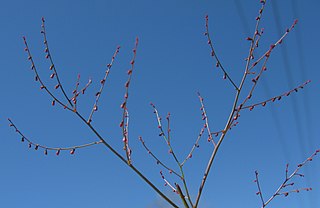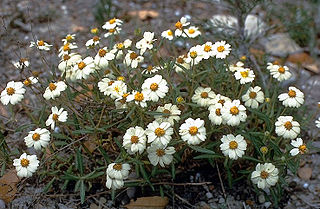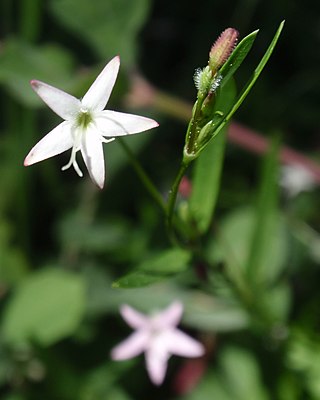
Scaevola is a genus of flowering plants in the Goodenia family, Goodeniaceae. It consists of more than 130 species, with the center of diversity being Australia and Polynesia. There are around 80 species in Australia, occurring throughout the continent, in a variety of habitats. Diversity is highest in the South West, where around 40 species are endemic.

Melastomataceae is a family of dicotyledonous flowering plants found mostly in the tropics comprising c. 175 genera and c. 5115 known species. Melastomes are annual or perennial herbs, shrubs, or small trees.

Leucas is a genus of plants in the family Lamiaceae, first described by Robert Brown in 1810. It contains over 200 species, widespread over much of Africa, and southern and eastern Asia with a few species in Queensland and on various islands in the Indian Ocean.

Calandrinia is a large genus of flowering plants known as purslanes and redmaids. It includes over 100 species of annual and perennial herbs which bear colorful flowers in shades of red to purple and white. Plants of this genus are native to Australia, western South America, Central America, and western North America. Some species have been introduced to parts of New Zealand, southern Africa, Asia, and Europe.

Olearia, most commonly known as daisy-bush, is a genus of flowering plants belonging to the family Asteraceae, the largest of the flowering plant families in the world. Olearia are found in Australia, New Guinea and New Zealand. The genus includes herbaceous plants, shrubs and small trees. The latter are unusual among the Asteraceae and are called tree daisies in New Zealand. All bear the familiar daisy-like composite flowerheads in white, pink, mauve or purple.

Actinotus is a genus of flowering plants in the family Apiaceae, subfamily Mackinlayoideae, with about 18 species. It is native to Australasia. Its best known member is the flannel flower, a common sight in Sydney bushland in the spring. The generic name, meaning "furnished with rays" is derived from the Greek stem aktin-/ακτιν- "ray" or "sunbeam".

Dianthera is a genus of flowering plants in the family Acanthaceae. It includes 41 species native to the Americas, ranging from eastern Canada to northern Argentina.

Leptactina is a genus of flowering plants in the family Rubiaceae. There are about 27 species. They are all native to sub-Saharan Africa, where most occur in rainforest habitat.

Gonocarpus (raspwort) is a genus of flowering plants in the family Haloragaceae. The species, which are native to Australia, New Zealand and Malesia, include:

Millerieae is a tribe of flowering plants belonging to the Asteroideae subfamily. Of all the genera, only Galinsoga, Guizotia, and Sigesbeckia have species native to the Old World.

Veronica stricta, synonym Hebe stricta, commonly called koromiko, is a flowering plant in the family Plantaginaceae, which is endemic to New Zealand.

Schoenus is a predominately austral genus of sedges, commonly known as bogrushes, or veldrushes in South Africa. Species of this genus occur mainly in South Africa, Australia and Southeast Asia. Others are found in scattered locations worldwide, from Europe to Asia, North Africa and the Americas. Three species occur in the peatlands of southern South America, including S. antarcticus which is found in Tierra del Fuego, where it forms a component of hyperhumid Magellanic moorland.

Kelloggia is a plant genus in the bedstraw and madder family, Rubiaceae. Its two species have a discontinuous distribution; one species is native to Bhutan and China, the other to the western United States.
Stillingia acutifolia is a species of flowering plant in the family Euphorbiaceae. It was originally described by George Bentham as Sapium acutifolium in 1842. Its native range includes Mexico, Guatemala, and Honduras.

Achyrospermum is a genus in the family Lamiaceae. It contains 23 species and can be found across Sub-Saharan Africa and Southeast Asia.
Adenosma is a genus of flowering plants belonging to the family Plantaginaceae.
Christisonia is a genus of flowering plants belonging to the family Orobanchaceae.

Paliavana is a genus of flowering plants belonging to the family Gesneriaceae.

Zanthoxyloideae is a subfamily of the family Rutaceae.















